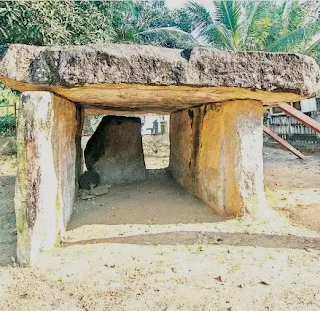Padavigampola, not far from the popular tourist hub Pinnawela Elephant Orphanage, is Sri Lanka’s most important megalithic monument. The typical trilith architecture is known from many parts of the world, though there were direct interconnections only with South India during this prehistoric period. Local legends attribute the impressive megalithic monument to mythical giants and a Buddhist saint.
On the gravel road in the village of Padavigampola, behind a Bo-tree, there is the megalithic monument called Gal Massa. It’s the only prehistoric dolmen in Sri Lanka and also the only large Stone Age structure on the island. It dates from around the 4th millennium BC and is therefore one of the very few elaborate structures from the millennia prior to the start of Sinhalese immigration.
Another name of this object, which is so exceptional for Sri Lanka, is Maliyadeva Guharamaya, because local tradition claims that Maliyadeva once lived here, who is believed to be the last monk in Sri Lanka who achieved Nirvana.
In Sri Lanka, the builders of this amazing large-scale stone construction, which requires the transport and lifting of enormous masses of stone, must have been local demons with the superhuman strength giants, the Yakkhas. On Indian mythology, Yakkhas are only semi-human beings. According to the historical chronicles of Sri Lanka, they were the island's native inhabitants alongside the Nagas, the snakes, prior to the advent of the Sinhalese. Of course, the Padavigampola dolmen is therefore also associated with the Indian Ramayana epic, in which the demons of Lanka play a leading role.
As with many European megalithic buildings, the large stones were nor quarried close to the site. The achievement of building the Gal Massa appears all the more gigantic.
Compared to other dolmens in Europe and Asia, the construction is downright classic: It is a trilithic structure, i.e. made of three stone slabs, two upright ones support the cover plate, which, however, is not exactly horizontal, but is inclined by 10 degrees. All three stone blocks are made of granite. They form a covered interior, which is closed off at the back by a smaller stone slab without a load-bearing function and was probably also bordered at the front by a gate stone, so that a real interior space was created.
The word “dolmen” is probably derived from Breton and Cornish and means “stone hole”.
The megalithic construction method of similar dolmens can be found along the entire coasts of Europe, North Africa and the Near East all the way to India. It is still unclear whether there was a common place of origin for this large stone construction method and where it was located, as is whether knowledge of this type of construction spread by sea, i.e. through prehistoric merchant shipping. Smaller forms were found in Palestine and were therefore viewed as early phases of development. Conversely, the oldest known large dolmens were found in France. There are reasons for theories expansion from east to west, but also for vice versa influences.
For creating a ceiling from a single stone slab, as is the case with the dolmen shape, it’s necessary to use correspondingly massive supporting stones. The construction alone requires certain formal elements, without any need to have been inspired by others. However, there will certainly have been regionally limited influences. The shape of the Gal Massa in Sri Lanka with two large supporting stones and smaller and narrower side stones just to delimit the interior, which in turn can have an entrance hole, is also known on the Indian west coast.







0 Comments